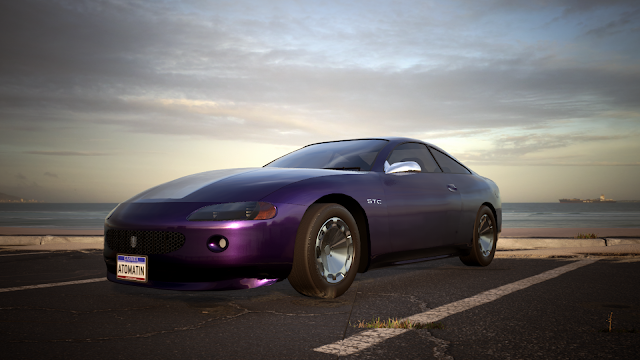Confessions of an Automationeer, Part 187: The Fourth of Four, and More Ups and Downs
After finally finishing the entire mid-engined LVC range for 1995, I realized there was a gap in their lineup for a front-engined grand tourer - the LS55. This was another two-seater, but with a larger front-mounted V12, displacing 5.0 liters (as opposed to the LS60's 4.0 liters) and developing 475 horsepower, sent to the rear wheels via a six-speed manual gearbox and a helical limited-slip differential. Weighing just 1.4 metric tons, thanks to its use of a glued aluminum monocoque chassis and aluminum body panels, it was still the heaviest car in their lineup at the time, being the only car in the range to have a full luxury interior and sound system (a high-end CD/cassette tape stereo, in keeping with contemporary trends).
Above, from top: The LVC LS55 adapts the company's contemporary design language (characterized mainly by a pair of vertically stacked headlights on each side and an elliptical main grille at the front, plus two circular taillight lenses per side at the rear) for use on a front-engined platform, making it look like a predatory animal from any angle (especially in side profile).
Initially, I felt doubtful about the idea of having a front-engined car in the 1995 LVC sports car range, but had a change of heart after realizing that they also would've had to appeal to a more grown-up section of their customer (and fan) base, one that valued practicality as much as performance - and this combo was something even the mid-range LS35 could not offer. So I finally got around to finishing this build, having left it in limbo for months. As my last fully detailed build of 2024, I am quite proud of how it turned out.
Above: The interior of the LS55 is even more luxurious than those found in its mid-engined siblings - a boon considering its greater focus on comfort and usability.
Regarding the '95 LVC sports car/supercar lineup, if their entry-level six-cylinder sports car, the LS25, focuses on skill, being the smallest, cheapest, lightest, and least powerful of the four, then the V8-powered LS35 supercar strikes a balance between pace, usability, and cornering, while the LS55 leverages its gimmick of torque and practicality, being a front-mid-engined grand tourer (due to the engine placement slider set to its rearmost setting) rather than mid-rear-engined as its stablemates are. Finally, the LS60, a limited-run flagship hypercar, has more power than lesser LVCs, and exploits this to the fullest with its full carbon-fiber construction and race-tuned pushrod-actuated suspension.
Above, from top: The 1995 LVC 2-seater lineup at a glance - consisting of the six-cylinder LS25 (yellow), V8-powered LS35 (red), front-engined LS55 (green), and all-carbon fiber LS60 (blue) - covers all bases by appealing to four different types of buyers within their clientele. The latter two are both V12-powered, but are aimed at very different types of buyer.
To finish things off, I'd like to discuss some of my highs and lows of the year. For me, the highest point was being able to finalize the design and engineering aspects of all four cars in the LVC sports car lineup, as well as finally completing a forum challenge that I'd hosted after several months. The lowest point, on the other hand, was the fact that I got the scoring wrong in that particular challenge - which may explain why it took so long to finish in the first place. However, I did eventually own up to, apologize for, and fix that particular mistake, and as such, I won't be put off hosting any other forum challenges for a very long time. You'll find out more about the challenge that gave me so much trouble in a future blog post, but in the meantime, enjoy the group shots I made showing the '95 LVC range. I'll see you all in the New Year.


















































